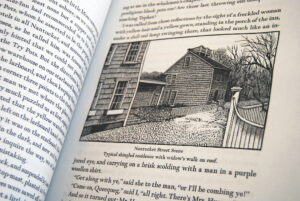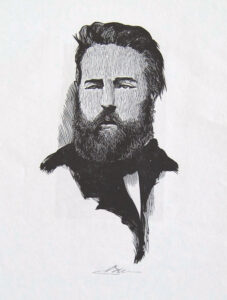 “If you hack the library without including print, you’re doing it wrong,” says Greg Eow, associate director for collections at the Libraries. Late last year, the Institute Archives and Special Collections received two fine press editions of Herman Melville’s Moby Dick; or, The Whale, both of which, Eow suggests, ask the reader to “reimagine what a book is.”
“If you hack the library without including print, you’re doing it wrong,” says Greg Eow, associate director for collections at the Libraries. Late last year, the Institute Archives and Special Collections received two fine press editions of Herman Melville’s Moby Dick; or, The Whale, both of which, Eow suggests, ask the reader to “reimagine what a book is.”
One is the first illustrated edition of Melville’s novel, with pen, brush, and ink drawings by Rockwell Kent, published by the Lakeside Press in 1930. The three-volume set is one of only a thousand copies.
The other is illustrated with letterpress engravings by artist Barry Moser, one of 265 copies published in 1979 by Arion Press. The oversized edition is bound in blue Moroccan goatskin and printed on handmade paper that bears a whale watermark. The Libraries also received a folio containing five of Moser’s original sketches and prints from the original blocks.
The books come as a gift from Daniel Seligson ’76, who first read Moby Dick as a physics undergraduate in a course with playwright and MIT professor A. R. Gurney. Seligson wanted to ensure the editions would be preserved, and the Institute Archives and Special Collections seemed like the ideal place for them.
 Seligson suspects some might think it odd that MIT would be interested in these books. “What people don’t realize is that it’s a great technical university with a very good liberal arts college attached,” he says. “It’s part of what makes MIT great. MIT without Hayden Library and all the things that support it would not be the kind of institution that it is.”
Seligson suspects some might think it odd that MIT would be interested in these books. “What people don’t realize is that it’s a great technical university with a very good liberal arts college attached,” he says. “It’s part of what makes MIT great. MIT without Hayden Library and all the things that support it would not be the kind of institution that it is.”
The gift fits within the Libraries’ collections, says Eow, not only because of MIT’s rich tradition in naval engineering and maritime history, but because the physical books themselves represent print as an unsurpassed technology for communication.
“The Arion Press book brings together engineering, art, and design with the written word, and allows us to think about the book beyond just an information delivery system,” he says. Encountering a book put together as thoughtfully as these two editions are is increasingly rare at a time when modes of communication are in flux. “It really allows us to see the power of materiality to command a reader’s attention.”


